Have you decided to get yourself a new welder? Considering you are here means that you did not jump the gun and got one of the first impulses.
It’s a good decision! Not all expensive branded MIG welders are worth their high price, and not all cheaper welders are junk boxes of scrap metal from China. We worked hard to find the best MIG welder in both 110v and 220v current variants.
![Best MIG Welders [110V & 220V] Reviews & Buyer's Guide 2024 1 featured image for best MIG welder article](https://weldingpros.net/wp-content/uploads/2022/10/best-mig-welders-1024x563.webp)
We made comparison tables and reviews of the top MIG welders for 2022 (in our opinion). Moreover, there is an extensive buyer’s guide and welder maintenance guide. Basically, most of everything you will need before and after you get yourself a new welder.
Don’t throw your money away but compare, read, and inform yourself before choosing the MIG welder suiting your exact needs. You will not waste your time, I promise.
Best MIG Welder For Every Budget [Quick Comparison Table]
110V MIG Welders
| Welder Image | Name | Voltage inputs | Output | Material thickness | Duty Cycle/Rated Output | Welding Process | Check Price |
|---|---|---|---|---|---|---|---|
![Best MIG Welders [110V & 220V] Reviews & Buyer's Guide 2024 2 Yeswelder YWM-211P welder](https://weldingpros.net/wp-content/uploads/2022/10/YesWelderDoublePulseMIGAluminumWelder_7_540x.webp) | YesWelder YWM-211P Pulse Aluminum MIG Welder Get 10% Off With Coupon: “-10% WELDPROS” | 110v & 220v | MIG (220V) 30-200A, MIG (110V) 30-160A. | Welds 24 ga up to 1/4 in mild steel or aluminum | 60% at Maximum Output | MIG/Pulsed MIG/Double Pulse MIG/Stick/TIG | Check Current Price YesWelder |
![Best MIG Welders [110V & 220V] Reviews & Buyer's Guide 2024 3 Image of a hobar handler 140](https://weldingpros.net/wp-content/uploads/2021/08/Hobart-500559-Handler-140-MIG-W_1-edited.webp) | Hobart 500559 Handler 140 MIG Welder | 110v/120v | 25–140A | Welds 24 ga up to 1/4 in mild steel | Rated Output at 20% Duty Cycle 90 A | MIG/FC | Check Current Price Northern tool Amazon |
![Best MIG Welders [110V & 220V] Reviews & Buyer's Guide 2024 4 arccaptain mig 200](https://weldingpros.net/wp-content/uploads/2022/11/arccaptain-MIG200.webp) | Arccaptain MIG200 MIG/Multi-process wel 5% Discount Code: “WELDPROS” | 110v/220V | 30-200A | Welds 24 ga up to 1/4 in mild steel | Rated Output at 60% Duty Cycle 200 A | MIG/FC Stick, Lift TIG | Check Current Price Arccaptain |
![Best MIG Welders [110V & 220V] Reviews & Buyer's Guide 2024 5 eastwood mig 180](https://weldingpros.net/wp-content/uploads/2021/08/eastwood-mig-180-package-content.webp) | Eastwood MIG 180, MIG/Flux Core Welder | 120v/240V | 30-180A | Welds 24 gauge – 5/16" MS | Rated Output at 30% Duty Cycle 90 A | MIG/FC | Check Current Price Eastwood |
![Best MIG Welders [110V & 220V] Reviews & Buyer's Guide 2024 6 Yeswelder MIG-205DS image](https://weldingpros.net/wp-content/uploads/2024/02/YesWelder-MIG-205DS-B-Multi-Process-MIG-Aluminum-Welder-2.webp) | YESWELDER MIG-205DS Welder Get 10% Off With Coupon: “-10% WELDPROS” | 110v & 220v | 30 - 160A (110V), 30 - 200A (220V) | Welds 24 ga up to 3/4 in mild steel | Rated Output at 60% Duty Cycle 160 A | MIG/Flux Core and Stick/TIG | Check Current Price YesWelder |
![Best MIG Welders [110V & 220V] Reviews & Buyer's Guide 2024 7 Forney-Easy-Weld-140-MP_1](https://weldingpros.net/wp-content/uploads/2021/08/Forney-Easy-Weld-140-MP_1.webp) | Forney Easy Weld 140 MP, Multi-Process Welder | 110v/120v | 10-140A | Welds 24 ga up to 1/4 in MS | Rated Output at 30% Duty Cycle 90 | MIG/FC/ Stick/TIG | Check Current Price Amazon |
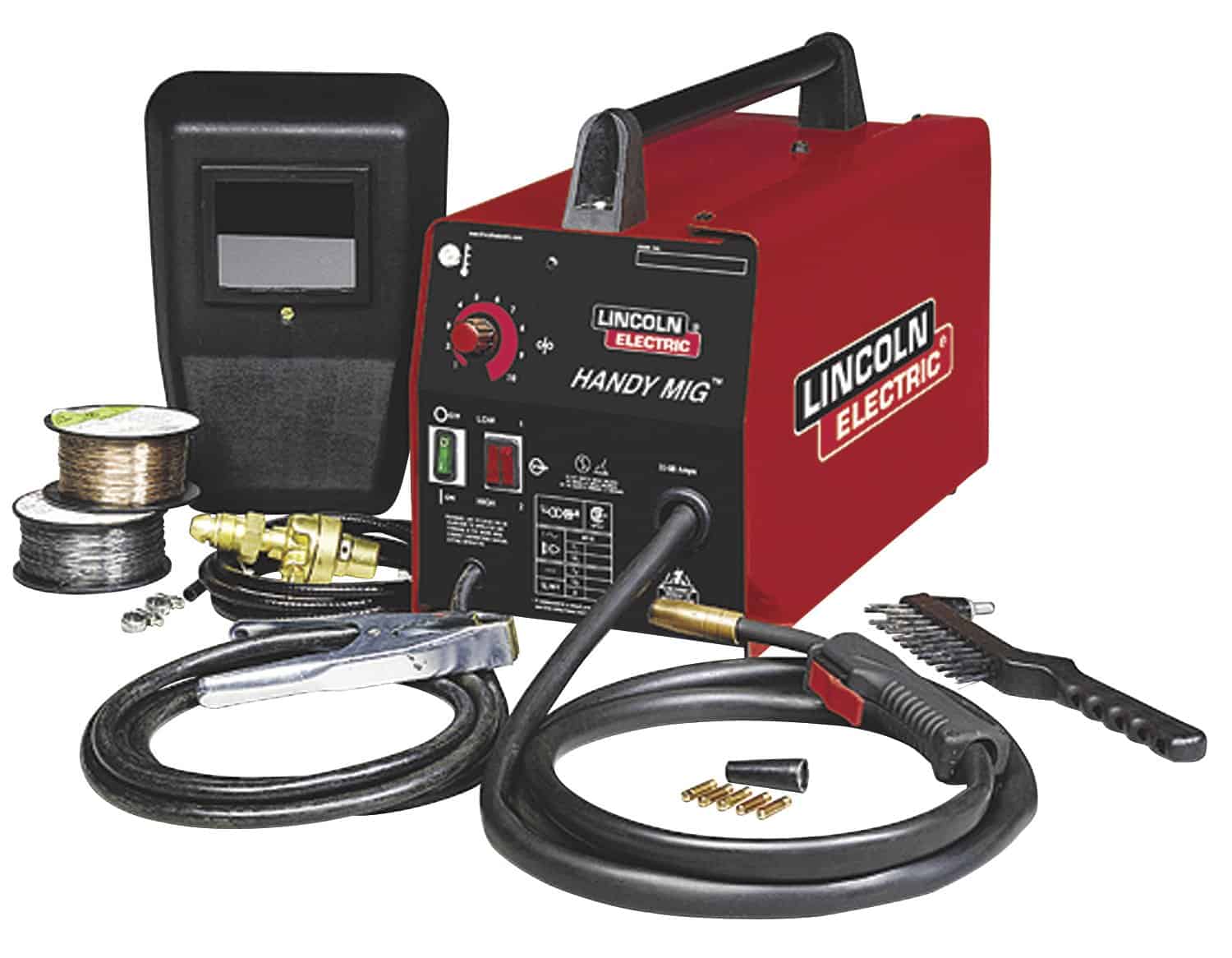
| Lincoln Electric K2185-1 Handy MIG Welder | 110v/120v | 25-140A | Welds 24 ga up to 1/8" in MS | Rated Output at 20% Duty Cycle 90 A | MIG/FC | Check Current Price Amazon |
220V MIG Welders
| Welder Image | Name | Voltage inputs | Output | Duty cycle | Welding Process | Check Price |
|---|---|---|---|---|---|---|
![Best MIG Welders [110V & 220V] Reviews & Buyer's Guide 2024 9 Image of a hobar handler 210MVP](https://weldingpros.net/wp-content/uploads/2022/10/Hobart-Handler-210MVP-Flux-CoredMIG-Welder-with-Multi-Voltage-Plug.webp) | Hobart - 500553 Handler 210 MVP MIG MIG Welder | 110v & 220v | 25 - 140A (115V). 25 - 210A (230V) | 115V 20% at 90 amps; 230V 30% at 150A | MIG/FC | Check Current Price Amazon |
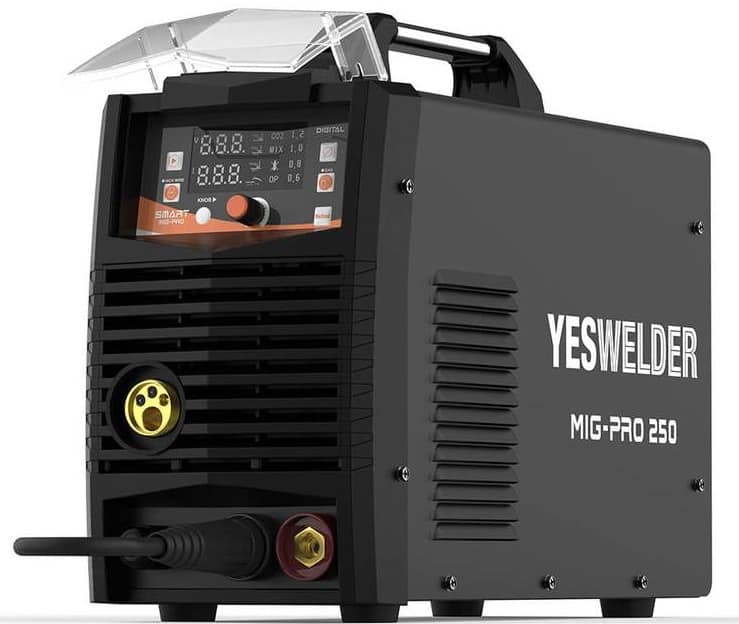
| YesWelder MIG-250A Pro Aluminum MIG Welder Get 10% Off With Coupon: “-10% WELDPROS” | 220v | MIG 40-250A, TIG 10-250A, Stick 20-220A | 220V MIG 60% at 250 amps | MIG/FC | Check Current Price YesWelder |
![Best MIG Welders [110V & 220V] Reviews & Buyer's Guide 2024 11 Image of a Lincoln Electric Power MIG 210 Mp Multiprocess Welder](https://weldingpros.net/wp-content/uploads/2022/10/Lincoln-Electric-Powermig-210-Mp-3.webp) | Lincoln Electric Power MIG 210 Mp Multiprocess Welder | 110v & 220v | 25 - 140A (115V). 25 - 210A (230V) | 115V 20% at 90 amps; 230V 30% at 150A | MIG/FC/ Stick/TIG | Check Current Price Amazon |
![Best MIG Welders [110V & 220V] Reviews & Buyer's Guide 2024 12 Image of a Lincoln Electric PowerMIG 180C K2473-2](https://weldingpros.net/wp-content/uploads/2022/10/Lincoln-Electric-PowerMIG-180C-K2473-2-1.webp) | Lincoln Electric PowerMIG 180C K2473-2 | 220v | 25 - 210A | 230V 30% at 150 amps | MIG/FC | Check Current Price Amazon |
![Best MIG Welders [110V & 220V] Reviews & Buyer's Guide 2024 13 Hobart Ironman 240 With SpoolRunner 200 (500574001)](https://weldingpros.net/wp-content/uploads/2022/10/Hobart-IronMan-240.webp) | Hobart Ironman 240 With SpoolRunner 200 (500574001) | 220v | 30 - 250A | 60% at 175 amps | MIG/FC | Check Current Price Northern Tool |
Best 110v MIG Welder reviews – Editor’s Picks
Below are some of the best reviews for MIG Welders (last updated 2022), and important information about the most popular brands and models in the industry.
- YESWELDER MIG-205DS MIG Welder
- The Hobart 500559 Handler 140
- Arccaptain MIG200 MIG-based, Multi-process Welder
- YesWelder YWM-211P Double Pulse Aluminum MIG Welder
- Lincoln K2185 – 1 Handy MIG Welder
- Eastwood MIG 180 FC/MIG Welder
- Forney Easy Weld 140 MP MIG Welder
- YesWelder MP200 5-in-1 Welder
These MIG welder reviews should help you choose the best welding unit for your needs. Keep in mind that all MIG welders essentially perform the same function. What separates each product from others is its application and additional manufacturer features and components.
1. YesWelder YWM-211P Double Pulse Aluminum MIG Welder
The Best Budget Welder With Pulse MIG & Synergy Settings
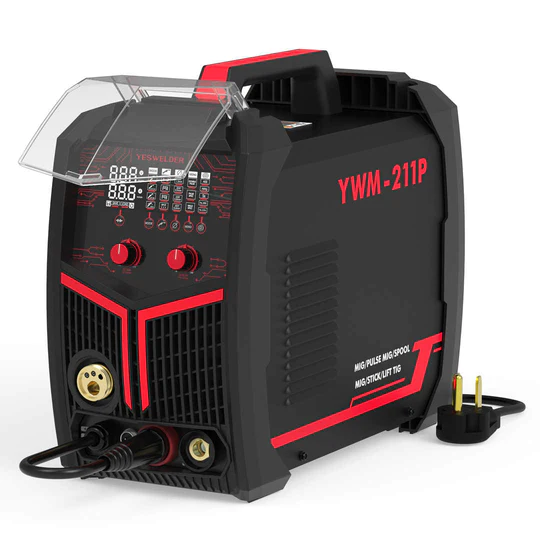
YesWelder YWM-211P
The YesWelder YWM-211P is the latest addition to a YesWelder line-up of feature-packed budget welders. This multi-process welding machine is mostly tailored for MIG aluminum welding but also shares characteristics with other more expensive welders such as double pulse MIG welding or synergy settings.
Get 10% Off With Coupon: “-10% WELDPROS”
| Processes: | MIG, Pulsed MIG, Double Pulsed MIG, Stick, DC TIG. | Welder Protection Rating | IP21S |
| Weldable Materials: | Steel, Stainless Steel, Aluminum with Spool-gun. | Input Voltage: | 220V/120V |
| Input Phase: | 1-Phase. | Current Type: | DC |
| Rated Output: | 220V: 60% at 200A, 110V: 60% at 150A | Amperage Range: | 220V: 30-200A, 110V: 30-160A |
| Wire spool diameter: | D100/D200 rolls (≤10lbs) | Weight: | 39.5 lbs |
This technology is still somewhat new in the welding industry. It’s not widely accepted, so many people still haven’t caught on to the benefits. However, the additional control over the pulsing waveform lets you manage heat input exceptionally well and have two very different pulses.
YWM-211P is a multi-process welder. So, besides double pulse MIG, you can also use DC TIG and stick welding. Plus, it officially supports the E6010 electrode, but we can’t vouch that it’ll have enough arc power for the welding pipe. The DC TIG function is rather basic. As a result, it doesn’t support a foot pedal control, and the TIG torch is not included.
While you cannot use this welder to TIG weld aluminum, YWM-211P is spool gun ready. Therefore, you can use it to MIG weld aluminum, and with pulse and double pulse options, you can even get TIG-like welds aesthetically wise. But, if you plan to tackle aluminum regularly, you will need to buy a spool gun, as it is not included in the package.
With a maximum output of 200 amps, YWM-211P is quite a capable welder you can use for your everyday light to medium-duty projects. Dual voltage increases versatility, and you can weld extended periods with a rated duty cycle of 60% at maximum output. Comparison-wise, most brand-name MIG welders, such as Lincoln Handy MIG, or Miller Millermatic, offer a 20-30% duty cycle. So with YWM-211P, you can weld longer.
YesWelder YWM-211P controls might seem confusing to beginners, with all the selection options and flashing lights. However, once you get the hang of them, you will realize how easy it is to use.
Beginners can opt for the Synergic MIG option, where the welder automatically adjusts voltage and wire feed speed according to input data.
Still, seasoned welders prefer simple buttons to select between the welding process (MIG, TIG, Stick), torch mode (2T/4T/4TL and Spot), wire diameter (.023-.45″), weld specifications (pulse or other parameters) and wire type. In addition, if you tackle the same jobs, including the same parameters repeatedly, you can save up to 10 presets, making everyday welding easier.
If you wish to read more about it, we have a dedicated full review.
Pros
- Multi-functional welder offering
MIG, TIG, and Stick welding options - Pulsed and double-pulsed MIG welding grants
TIG-like aesthetics - Well-built and sturdy machine
- Synergic MIG controls for beginners
- Can MIG weld aluminum with an optional
spool gun - High-rated duty cycle
- Excellent command over the entire welding process
- Memory mode can store up to 10 welding presets
Cons
- DC-only machine, meaning you cannot TIG weld aluminum
- TIG torch is not included
- Spool gun for aluminum is sold separately
2. The Hobart Handler 140 500559 MIG Welder [Best Overall]
The Best Time Tested MIG Welder
![Best MIG Welders [110V & 220V] Reviews & Buyer's Guide 2024 14 Hobart 500559 Handler 140 MIG W 1 edited](https://weldingpros.net/wp-content/uploads/2021/08/Hobart-500559-Handler-140-MIG-W_1-edited.webp)
The Hobart Handler 140
Now, unlike YesWelder above, the Hobart handler 140 offers better quality but not at a perfect price-to-quality ratio. This means that you are effectively paying more than you get if we compare it to the other beginner welders on the market. However, the price is justified thanks to Hobart’s impeccable quality control, the industry’s leading warranty, and beautiful Hobart’s arc.
| Processes: | Flux Core (FCAW)/MIG (GMAW). | Weld Thickness Range: | Plain-carbon steel – 24 ga. – 1/4 in. |
| Weldable Materials: | Steel, Stainless Steel, Aluminum with Spool-gun. | Input Voltage: | 110/115/120 V, 60 Hz. |
| Input Phase: | 1-Phase. | Current Type: | DC |
| Rated Output: | 90 A @ 20% duty cycle. | Amperage Range: | 25A – 140A. |
| Wire Feed Speed: | 40 IPM – 700 IPM. | Weight: | 57 lbs. |
When you look at the benefits and drawbacks of this Hobart welder, you need to consider that this is a transformer welding machine. Meaning, a longer-lasting durable welder with good arc quality and minimal spatter but also a heavier machine with a smaller duty cycle and features that lag behind the newer inverter welders.
The arc quality is much better than what most cheaper MIG welders provide, like Lotos, Forney, and Yeswelder. All of which offer a higher duty cycle but a less smooth and stable arc. Still, the maximum output of 140A won’t let you weld steel thicker than 1/4 in. compared to 3/4 inch steel with the 205DS above.
The first thing I find frustrating with Handler 140 MIG Welder is its poor duty cycle. While they’ve invested a lot in the unit’s durability and weld quality, I wish the welder had at least 30% at 100A of output. Instead, you are capped at 20% at 90A. That’s quite low, so expect downtimes while the machine cools down unless you are just tack-welding metal or running small beads here and there.
The preset 5-position voltage knob limits your adjustability range. This is good if you like a simple setup, but it’s bad if you want to fine-tune your arc. In addition, sometimes, you may not be satisfied with the bead width, penetration, and height because of other factors influencing your weld.
Infinite adjustability knobs are almost an industry standard today because they can offset many factors like metal and environment temperature and humidity, metal’s cleanliness, and others.
Hobart is a good choice if you don’t mind paying more for better arc quality and quality components. Just keep in mind that it’s heavier than most beginner welders with its 57 lbs, thanks to the transformer inside. If you are just learning how to weld and you know you’ll get a more powerful welder down the line, it’s probably better to get a cheaper machine than Handler 140, or just get a Handler 210 right off the bat.
But if you are a hobbyist looking for maximum reliability and warranty and the Handler 140 satisfies your needs, it’s definitely a good choice for gas metal arc welding, especially thin sheet metal work.
For a more extensive review of this Hobart Handler, click here.
Pros
- Ease of use
- Covered with 5/3/1 Hobart warranty
- Compact for usage and storage
- Easy setup
- Versatile
Cons
- Small voltage
- Heavy machine
- Loud cooling fan
3. YesWelder MIG-205DS MIG welder [Best For the Money]
The Best MIG Welder For The Money
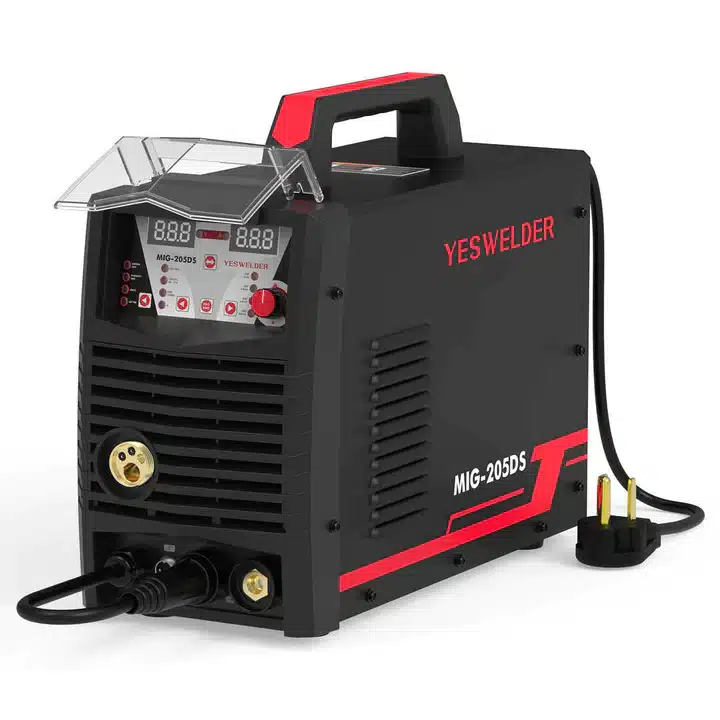
YesWelder MIG-205DS
YesWelder MIG-205DS provides the best value in the MIG welder market. This doesn’t mean it’ll outperform Hobart or ESAB in terms of quality, but it provides what the average hobbyist needs for a fraction of the big brand prices. YesWelder 205DS is a dual voltage MIG welder, but it’s capable of doing flux-core, stick, and even lift arc TIG welding processes.
Get 10% Off With Coupon: “-10% WELDPROS”
| Processes: | MIG (GMAW), DC TIG (GTAW), Stick (SMAW), Flux Core | Weld Thickness Range: | Plain-carbon steel welds up to 3/4 in. |
| Weldable Materials: | Steel, Stainless Steel | Input Voltage: | Both 110/220V |
| Input Phase: | 1-Phase. | Current Type: | DC |
| Rated Output: | 90 A @ 20% duty cycle. | Amperage Range: | 25 A – 140 A. |
| Wire Feed Speed: | 590 IPM | Max Wire Roll Diameter: | 8” |
| MIG/TIG Settings | Synergic-MIG, Lift TIG | Weight: | 23 lbs. |
Most “dual-voltage” MIG welders offer limited amperage output at 110V. But, the MIG-205DS has enough power for standard MIG welding tasks. With its 160A of output at 110V, it provides more power than Hobart 140 and 210.
While brands like Hobart and Lincoln offer better arc stability, the MIG-205DS only provides a decent arc for basic welding needs. So expect some spatter, arc fluctuations, and similar.
The MIG-205DS has a digital display but a bit complex interface. However, what I like the most is the ability to fine-tune everything, thanks to the infinite adjustability knob. Plus, the Synergic-MIG automatically sets voltage and wire feed speed according to your material thickness selection.
For some people, this is not an issue considering these are home and small shop welders, but it is worth mentioning that more expensive MIG welders like Hobart 140 and 210 that are on our list, have “fixed voltage values.” The drawback that makes fine-tuning your settings impossible. On the other hand, if you can get past the fact that it’s a welder from China. You will get infinite dial settings on YesWelder 205DS for something like half a price.
Waight and portability, Yeswelder’s 205DS is a 33lb inverter machine which in itself makes it much lighter than Hobart and, with its massive handle on top, makes it portable enough, at least around the shop.
On the other hand, if you need even lighter welding machines, the Eastwood 180 is almost 10lb lighter, so scroll down to read its review if you are looking for maximum portability.
![Best MIG Welders [110V & 220V] Reviews & Buyer's Guide 2024 15 Driverools MIG 205DS 300x225 1](https://weldingpros.net/wp-content/uploads/2022/10/Driverools-MIG-205DS-300x225-1.webp)
In terms of build quality, YesWelder 205DS is hard to beat in its price bracket. It has a full metal wire drive system, which is difficult to find in entry-level machines. For example, the Lincoln Handy MIG welder reviewed below has a plastic feed system while offering significantly fewer features and less power.
The 205DS cannot weld aluminum. It is not spool gun capable. You should read the rest of the reviews below if this is a deal-breaker. The other MIG Pro 250A machine from YesWelder can handle aluminum, and it’s also on this list.
Overall, this is an excellent choice for beginners, small projects, DIY hobbyists, artists, and weekend warriors. With a 1-year warranty, ideal price to quality ratio, decent arc stability, a lot of welding power, and excellent duty cycle, it’s WeldingPros’ top pick among the best MIG welders for the money.
More on this 110v/220v welding machine here.
Pros
- Very affordable
- Useful features in a low-priced welder
- High duty cycle
- Lift arc start for TIG
- Dual voltage machine
- Full metal wire feeder
- 1-year warranty
Cons
- TIG torch not included
- Loud cooling fan
- Knurled drive roller does not come with the package
4. Arccaptain MIG200 – Budget-friendly MIG Welder With Synergic Settings
The New Budget Welder WIth Synergic MIG
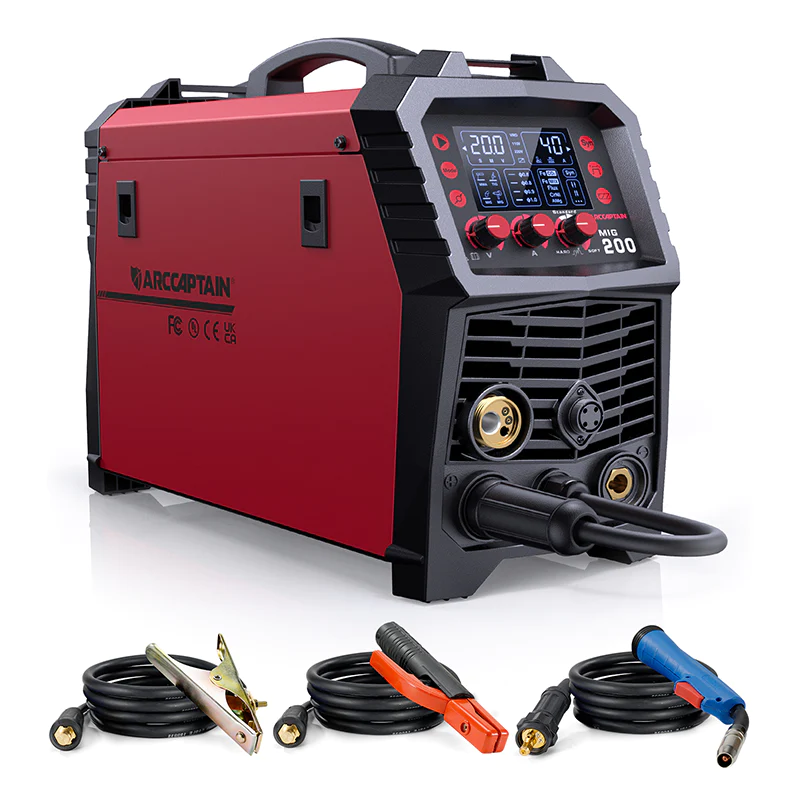
Arccaptain MIG200
Arccaptain is not a new welding equipment manufacturer, but on our list, we included their latest addition to a lineup, an Arccaptain MIG200 welder. This is a budget-friendly MIG-based machine that also provides Flux core, Stick, and lift TIG capabilities. The pro of the latest MIG welding machines, including MIG200, is that they provide advanced features at a reasonable price.
5% Discount Code: “WELDPROS”
| Processes: | MIG, Flux core, Stick, DC TIG. | Weld Thickness Range: | Plain-carbon steel – 24 ga. – 1/4 in. |
| Weldable Materials: | Steel, Stainless Steel, Aluminum with Spool-gun. | Input Voltage: | 220V/120V |
| Input Phase: | 1-Phase. | Current Type: | DC |
| Rated Output: | 220V: 60% at 200A, 110V: 60% at 135A | Amperage Range: | 220V: 30-200A, 110V: 30-135A |
| Wire spool diameter: | 2 lbs, 10 lbs | Weight: | 28.2 lbs |
MIG 200, therefore, features IGBT technology, making it lightweight, efficient, and powerful. The first look at Arccaptain MIG 200 leaves an impression of a well-built and sturdy machine. My claims are backed by the IP21S protection rating that proves the unit passed tests in simulating extremely harsh environments such as dirt, water, or dust.
With a dual voltage capability, you can run it off a regular 110V household outlet or dedicated 220V power source. At 220V, this machine is capable of outputting 30-200 A as a MIG welder, which is more than enough for your DIY, home repair, hobby projects, and more. In addition, you can weld without making frequent breaks with a 60% duty cycle rated at a max output of 200 amps.
Beginner welders will appreciate synergic MIG controls. The welder will automatically adjust voltage and wire feed speed according to MIG wire diameter and selected material. Meanwhile, seasoned welders can fine-tune their machines using manual mode, and there is a MIG inductance setting that can reduce the spatter. These are usually reserved for pricier machines like Miller Millermatic or Lincoln Power MIG.
As an old-school welder, I was not too fond of the fact there is no reference chart. However, it seems like it is the new trend for welders that include synergic settings, which will give you a needed head start. Nonetheless, I found Arccaptain MIG200 easy to set up and use. A large 4.3″ LED screen will show exact values, and there is a memory mode that saves your last settings for the following welding job.
Like other budget manufacturers, the accessories don’t seem like the highest quality ones, but they will get the job done. Additionally, you will need to buy a separately sold spool gun to MIG weld aluminum.
New machines and manufacturers often bring out doubt since it is just hard to beat the reliability of Miller or Lincoln. Nonetheless, MIG200 is well protected by over-current, voltage, and temperature protection features, as well as a 2-year warranty. As a result, there is no doubt this MIG welder will last an perform.
Read our dedicated full review.
Pros
- Great value for the money spent
- High power efficiency and duty cycle
- Various controls with large LED screen
- Synergic MIG controls
- Lightweight but sturdy
- Tested in harsh conditions
- Great for hobby, DIY, and home repair projects
- Protection features and a 2-year warranty
Cons
- Not the highest quality accessories
- No reference chart for controls
- Spool gun is sold separately
5. AHP AlphaMIG 231MS – Heavy-duty MIG Welder
Best Heavy Duty Welder For Home Use
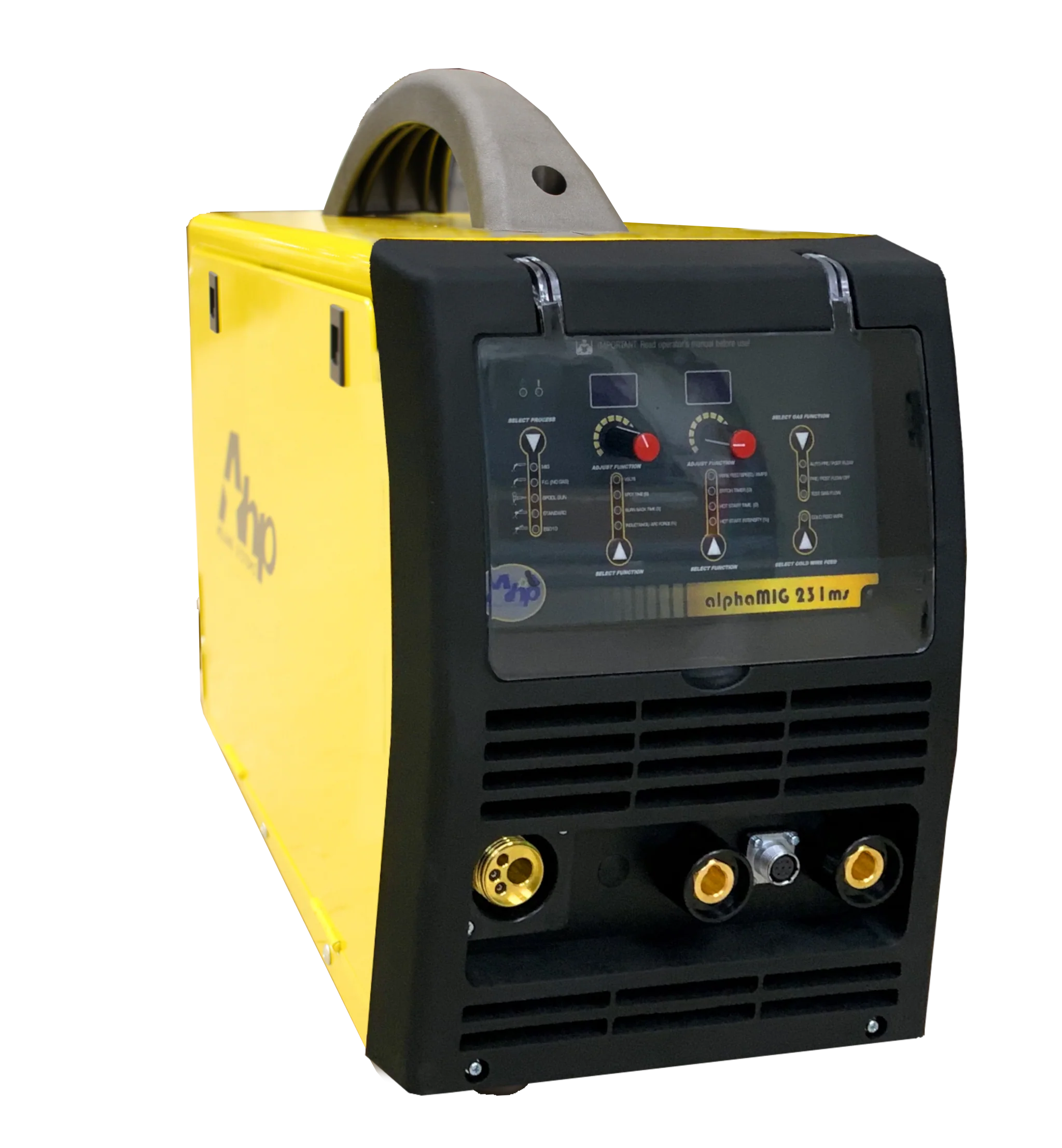
AHP AlphaMIG 231 MS
AHP AlphaMIG 231MS is a heavy-duty IGBT inverter-based MIG and Stick welder that is built to last and perform.
This inverter welder is excellent for everyone looking for a potent, portable, and reliable MIG/Stick welding machine. The first thing I, and many other welders, liked about AlphaMIG 231MS is the build quality.
Get 10% Off With Coupon: “-10% WELDPROS”
| Processes: | MIG/Stick welding | Welder Protection Rating | IP21S |
| Weldable Materials: | Steel, Stainless Steel, Aluminum | Input Voltage: | 220V/120V |
| Input Phase: | 1-Phase, 120V/240V | Current Type: | DC |
| Rated Output: | 50% @ Max output | Amperage Range: | 30-230A; 15.5-24.5V |
| Wire spool diameter: | Size 8″ and 12″ | Weight: | 65 lbs. |
This welder provides the perfect combination of durability and portability, and it seems like it can last many years of everyday use, especially compared to cheap Chinese units. I loved that you get everything you need to weld straight out of the box, including accessories and a few consumables (without wire or electrodes). However, many disliked the 10 ft. long leads on the torch and electrode holder, which can come short in specific applications.
Regarding welding capability, AlphaMIG 231 MS is quite a powerful welder with a maximum output of 230 amps. Even though it supports dual voltage with 110/220V input, the machine really shines at 220V. With a 50% duty cycle at maximum output, this is truly your workhorse, designed to operate without many interruptions. While compact, the unit supports the use of both 8″ and 12″ rolls, which can fit 10 to 44 lbs of wire. It will also easily handle from .023″ to .045″ diameter solid steel or stainless wire with the included drive rolls.
AHP AlphaMIG 231 MS is a spool-gun-ready welder, which means you can weld thick aluminum up to 1/8″ with a separately sold gun. Additionally, AHP offers a polymer liner, which you can fit to ensure smooth aluminum wire feed. When it comes to steel, it can weld 24 gauge up to 5/16″ in a single pass, or up to 1/2″ in multi-pass operation.
Stick welding with AHP AlphaMIG 231 goes surprisingly well. Even though this is an inverter-based machine, ti can run the notorious 6010s. However, you’ll have to tune functions like hot start and arc force control to do so. Nevertheless, the arc start is easy, and the arc overall is really smooth.
Pros
- Durable and well-built inverter welder
- Robust but compact and portable
- Dual voltage
- Heavy-duty power and duty cycle
- Can fit larger spools and wire diameters
- Spool gun ready
- Various features such as hot start, arc force, spot time, stitch welds, cold wire
- Can run 6010s
Cons
- Leads are somewhat short
- Can be heavy with added larger spools of wire
6. Lincoln Electric K2185 – 1 Handy MIG Welder
Time Tested MIG Welder
![Best MIG Welders [110V & 220V] Reviews & Buyer's Guide 2024 16 Lincoln Electric K2185 1 Handy MIG Welder 1](https://weldingpros.net/wp-content/uploads/2021/08/Lincoln-Electric-K2185-1-Handy-MIG-Welder_1.webp)
Lincoln Electric K2185 – 1
Lincoln Electric Handy MIG Welder is affordable, but it doesn’t offer nearly as many features like Forney 140 MP (reviewed below) or YesWelder 205DS. All of which are in a similar price range. Lincoln Electric is a serious USA brand, but this is the most basic unit they sell. It’s meant for very limited hobbyist use because its maximum output is just 88A, and it has a duty cycle of just 20% at 70A.
| Processes: | Flux Core (FCAW)/MIG (GMAW). | Weld Thickness Range: | Plain-carbon steel up to 1/8 in. |
| Weldable Materials: | Steel, Aluminum with Spool-gun, non-corroding alloys. | Input Voltage: | 110/115/120 V, 60 Hz. |
| Input Phase: | 1-Phase. | Current Type: | DC |
| Rated Output: | 70A/17V/20% duty cycle. | Amperage Range: | 35A -88A |
| Wire Feed Speed: | 0-300 ipm. | Weight: | 46 (20.9 kg) |
Lincoln Electric K2185 can’t weld thicknesses above 1/8 in. – mostly suitable for thin sheet metal welding. However, it has a decent build quality, and most importantly, you can have peace of mind when buying from a brand like Lincoln. If anything goes wrong, their customer support will take care of you. This is important for many people, especially beginners.
Additionally, just like Handler above, it’s a transformer-based welder. This makes it more durable than the average inverter unit. Couple this with its incredibly low price, and you can see Lincoln’s reasoning behind this MIG welding unit. It’s meant to provide transformer-level durability in the cheap welder market, but this means minimal features and power output.
I don’t like that it has a plastic wire feed system. It’s not flimsy, but plastic is not the way to go. This is the only welder with a plastic drive on our list. We included it because it’s excellent value for the money if you are looking for a reliable, basic MIG machine and you want to stick to industry-leading brands.
Overall, don’t expect anything crazy from Lincoln Electric Handy MIG. It’s good enough to learn the ropes, it’s cheap, transformer-based, does MIG and flux core welding, and if you are not too rough with it, its plastic parts should hold up.
The full review here
Pros
- Ease of use
- Easy setup
- Lightweight design and compact for usage and storage
- Compact and portable
- Low skill level needed to operate
Cons
- Not intended for industrial use
- Welds only Low Carbon Steel up to 1/8”
7. Eastwood MIG 180, MIG/Flux Core Welder
MIG Welder With The Best Price To Warranty Ratio
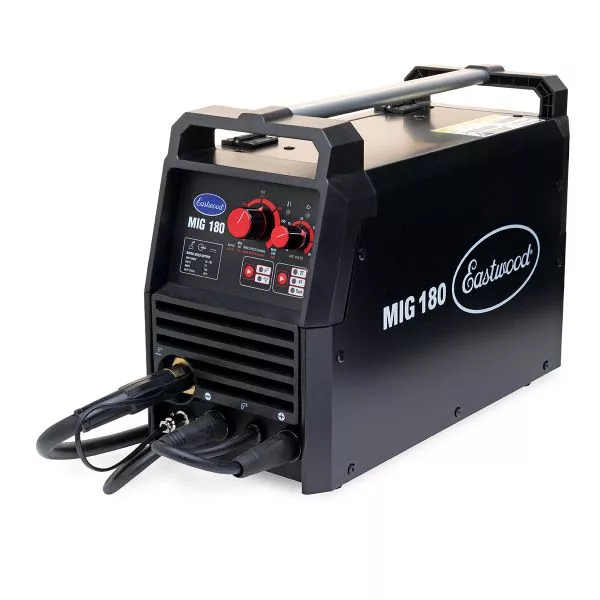
Eastwood MIG 180
Eastwood MIG 180 is more expensive than the YesWelder 205DS, but it offers additional features, a lengthier warranty, and slightly better build quality. It’s cheaper than the Hobart Handler 140 while providing a similar 3-year warranty.
| Processes: | Flux Core (FCAW)/MIG (GMAW). | Weld Thickness Range: | 24 gauge – 5/16 inch. |
| Weldable Materials: | Plain-carbon steel, Stainless steel, Aluminum. | Input Voltage: | 120/240V |
| Input Phase: | 1-Phase. | Current Type: | DC |
| Rated Output: | 110V: 30% @ 90A, 220V 30% at 180 Amps | Amperage Range: | 30A – 180A |
| Wire Feed Speed: | 110V: 80 – 280 ipm, 220 volts: 80 – 551 ipm. | Weight: | 25.3 lbs. |
If you are not looking for other welding processes besides MIG welding, then this dual voltage Eastwood is a bit better choice than the YesWelder 205DS. With its maximum output of 180A and a 60% duty cycle at 130A, it’s inferior to the 205DS but much better than Handler 140A. Additionally, its 110V input performance is capped at 120A output which is much lower than 160A at 110V the YesWelder offers. Effectively allowing you to weld up to 5/16 in. on 220V and 3/16 in. thick with 110V input.
However, the Eastwood MIG 180 offers the support for a spool gun, a more intuitive control panel with two infinite adjustability knobs, and it’s 10lbs lighter than the YesWelder 205DS, making it the lightest MIG welder in our comparison. It offers tack weld settings and 2T/4T, which are helpful in everyday shop work. This unit is meant for light welding shop use, hobbyists, and beginners who want a powerful welder that supports a spool gun while staying under 500 bucks.
But, it doesn’t handle thin metal well. You can get inconsistent results. Plus, its minimal amperage output is 30A. At the same time, the Handler 140 has a minimal amperage output of 25A and provides more stable, consistent results.
This Eastwood model has one problem. The gas inlet valve is placed in the middle of the back panel. Typically, welders have this valve at a side of the back panel so that if you use the welder on the wheeled cart, the gas hose doesn’t get kinked from the gas bottle sitting right behind it. The worst thing about it is that their own cart has this problem with the unit, but most other carts will also pinch the gas hose.
However, with a full metal wire drive system, decent quality MIG gun, good unit housing build quality, and 3-year warranty, it’s a pretty good MIG welder worth considering. Additionally, it comes with one of the best instruction manuals I’ve ever seen in the affordable welder’s market. It’s definitely a fool-proof machine anyone can learn to use quickly to make quality welds.
The full review is here.
Pros
- 2T/4T options and Tack weld mode
- IGBT inverter tech makes it
compact and lightweight - Infinite control of the voltage and wire speed
- Tweco style torch
- Braided wire strap on the ground clamp
- Can weld up to 1/8″ aluminum with optional spool gun
- Offers great value for the money spent
Cons
- Short leads
- No knurled drive roller
- Only use 11-pound rolls of wire
8. Forney Easy Weld 140MP MIG Welder
The Best MIG Welder For Small Jobs
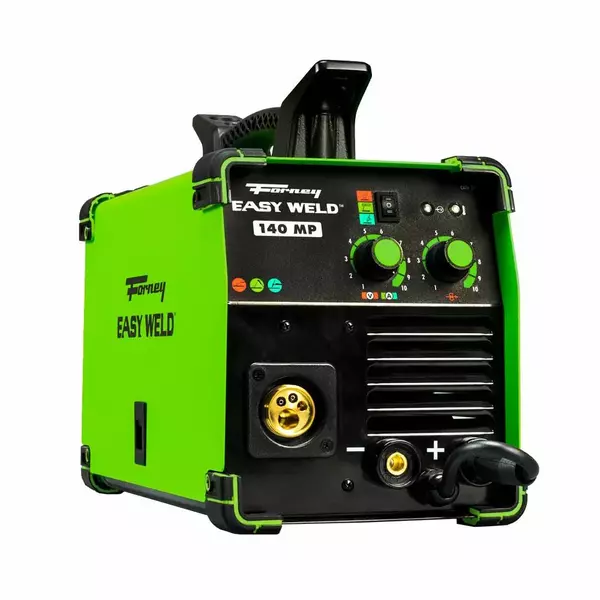
Forney Easy Weld 140MP
This is an inverter welder meant for hobbyists and light welding work. It’s portable, light, and has the most basic rugged features like rubber points at all 8 corners. So, it can handle a bit more rough handling than most beginner welders on this list.
| Processes: | Flux Core (FCAW), MIG (GMAW), STICK (SMAW), TIG (GTAW) | Weld Thickness Range: | 24 gauge up to 1/4″ |
| Weldable Materials: | Plain-carbon steel | Input Voltage: | 120v |
| Input Phase: | 1-Phase | Current Type: | DC |
| Rated Output: | MIG 30% @ 90A | Amperage Range: | 10 – 140 AMP |
| Wire Feed Speed: | 79 – 197 ipm. | Weight: | 24.8 lbs |
Forney Easy Weld 140 uses an almost identical metal wire feed system like the Eastwood 180. It’s a good design found in quality low-priced machines. Forney 140MP is easy to use with its two infinite adjustability knobs and a single switch for welding processes.
Forney Easy Weld 140 is a multi-process machine, just like the YesWelder 205DS. It does MIG, flux-core wire welding, stick, and DC TIG. However, it’s more expensive than the 205DS and Eastwood above while offering similar budget welder weld quality.
It’s the lightest multi-purpose welder you can get, with just 24.8 lbs. But the YesWelder Firstess above is significantly better in performance, and it’s a better choice if it fits your budget. If not, the YesWelder 205DS is cheaper than Forney while offering more welding power, but it’s 8 lbs heavier.
Forney 140 MP is a 120V welder with a maximum output of 140A, just like the Hobart Handler 140. But it has a duty cycle on the lower end at just 30% with 90A for the MIG welding process.
This machine is suitable for someone who needs a bit more ruggedness and portability than what YesWelder and Eastwood offer. But the downsides are the higher price (costs almost as the Hobart Handler 140) and lower welding power. In my opinion, the price is a bit too high considering Forney offers just one year warranty.
The full review is here.
Pros
- Wire loads easily and quickly.
- Adjustable feed speed
- Compact
- Power efficiency
- Low skill level needed to operate
- Lightweight
- Compact and portable
Cons
- Gas regulator and TIG gear not included
- No spool gun support
9. YesWelder FIRSTESS MP200 5-in-1 Welder & Cutter
The Best MIG Welder With Integrated Plasma Cutter
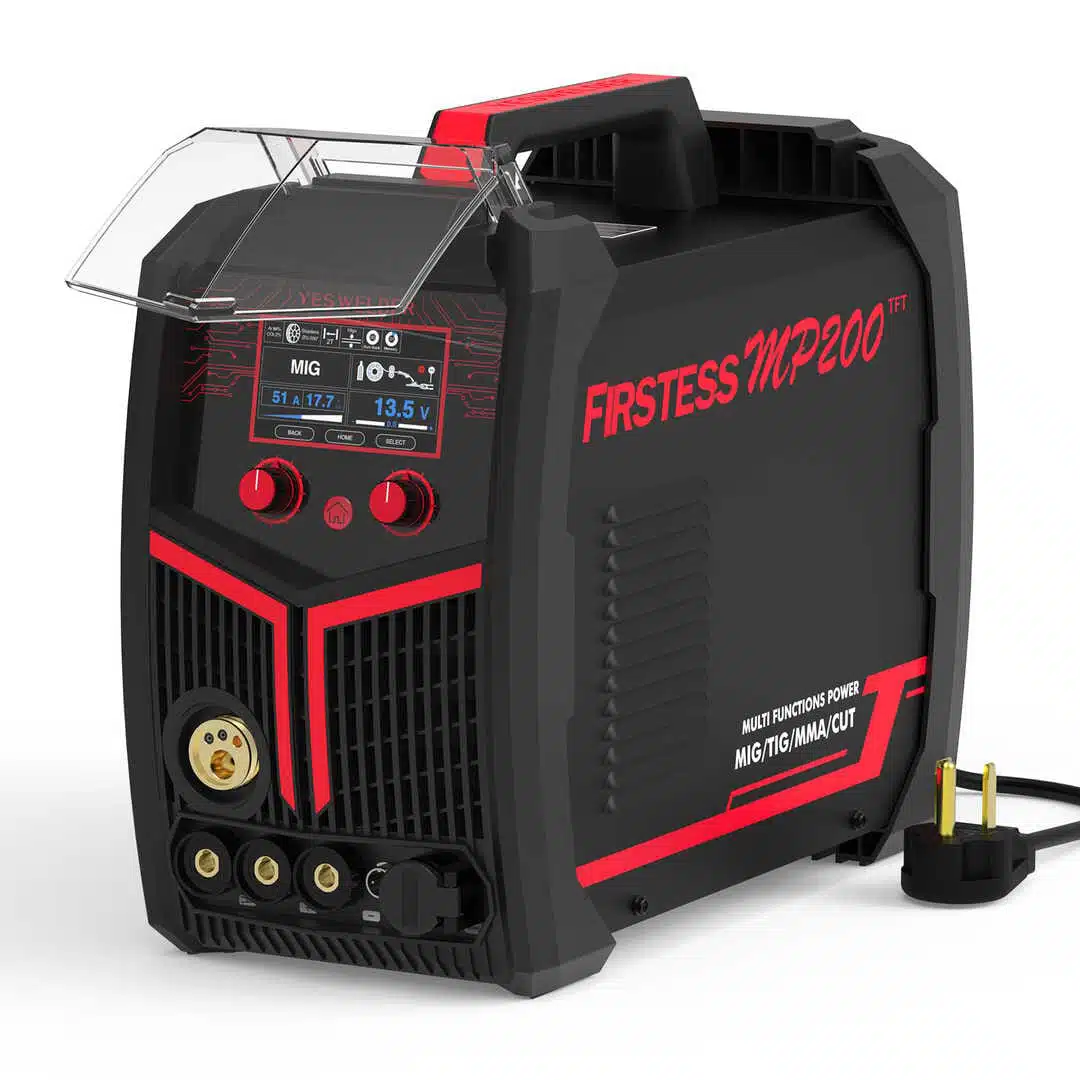
YesWelder FIRSTESS MP200
The MP200 is the most optimal MIG welder for home and garage use with multi-process welding and cutting capabilities you can get in this price range. Period. MP200 supports both gas and gasless wire and supports both automatic and manual settings.
Get 10% Off With Coupon: “-10% WELDPROS”
| Processes: | FCAW, GMAW, GTAW, SMAW, and Plasma Cutting | Metal Thickness MIG: | .031″-0.27″ (0.8-7.0mm) |
| Input Voltage: | 110/220V | Metal Thickness TIG: | .031″-.098″ (0.8-2.5mm) |
| Current Type: | DC | Metal Thickness SMAW: | .059″-0.19″ (1.5-5mm) |
| Weldable Materials: | Steel, Stainless-Steel | Amperage Range Weld/Cut: | 20-200A/20-40A |
| Input Phase: | 1-Phase | Rated Output: | 60% at 68F, 25% at 104F |
| Wire Feed Speed: | 2.2 yd/min – 16.4 yd/min. | Weight: | 25lbs |
I know you are looking for a MIG machine, but this dual voltage welder also does stick, lift TIG, Flux Core welding, and plasma cutting! All for a price that’s more than fair. On the MIG side of things, Speaking of which, its synergic controls allow for automatic wire feed and voltage adjustments based on your amperage input alone.
You will have a much easier time handling the arc, especially if you are a beginner. It has a full metal drive system just like Hobart, Miller, or other brand names. The machine is sturdy, in fact, it feels more premium and durable than other YesWelder machines. The MP200 can actually take some rougher working conditions.
Your MIG arc will be stable and without excessive spatter. The inverter technology is designed well to handle the electricity flow efficiently for a nearly flawless experience. With its duty cycle of 60% at a maximum output of 200A, you are getting a far better deal than with most brand names like Hobart 210, which does 30% at 150A, for example.
The MP200 is aimed at beginners, DIY hobbyists, and light welding shop use. Unfortunately, it’s unable to join aluminum at all.
That’s the only downside, from what I can tell. No spool gun support or AC TIG. While AC to TIG aluminum is entirely unrealistic at this price point, the spool gun support is something YesWelder should consider.
After all, they do sell a model capable of MIG welding aluminum thanks to the graphene hose liner, the YesWelder MIG 250 Pro. Maybe they can introduce this feature in the MP200 as well.
![Best MIG Welders [110V & 220V] Reviews & Buyer's Guide 2024 17 Image of a welder adjusting wire speed front panel on Firstess MP200 edited](https://weldingpros.net/wp-content/uploads/2021/10/Image-of-a-welder-adjusting-wire-speed-front-panel-on-Firstess-MP200-edited.webp)
But let’s be real here. For the price of this unit, you are getting an incredible value. Dual voltage, portable, ease of use and large digital screen, 5 processes including plasma… You are unlikely to find a better deal for light use. I will encourage anyone who doesn’t need to work with aluminum to check out this machine. Besides excellent MIG capabilities, you are getting a whole metalworking setup ready to start welding out of the box.
If you wish to read more about it, we have a dedicated full review.
Pros
- 5-in-1 Machine, including a plasma cutter.
- Dual voltage power input
- High duty cycle
- Intuitive large digital display
- Automatic and manual controls
- Ten memory settings
- Full metal wire feed system
- Best value for the money
Cons
- Not recommended for heavy-duty jobs
- No option to weld aluminum
Best 220v MIG Welder reviews – Editor’s Picks
These are the best 220v MIG welders, rigs with a little more welding power in them. 220v models are usually more expensive, but much more powerful.
- Yeswelder MIG Pro 250 220v MIG Welder
- Hobart Handler 210 MVP 220v MIG Welder
- Lincoln Electric Power MIG 210 Mp K3964-1
- Lincoln Handheld, 208/230VAC
- Hobart IronMan 240 with SpoolRunner 200
They can prove quite useful if you regularly weld thicker steel up to 1/8’ or aluminum. With these machines, you have more room to work on developing your hobby or profession.
Some of these best MIG welders come as dual voltage machines (110V/220V) making them mobile and diverse. Please read the reviews (buying guide) and features for each, so you can make the best choice possible.
1. YesWelder MIG Pro 250A MIG Welder
The Best MIG Welder For Aluminum Without Spool Gun
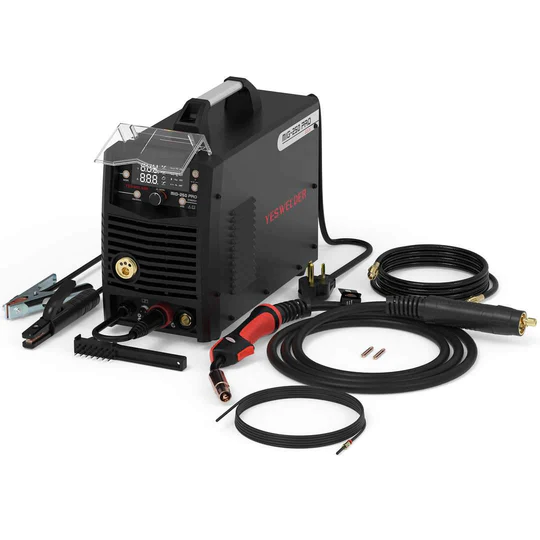
YesWelder MIG Pro 250A
YesWelder MIG Pro 250A is a powerful 220V MIG welder, but it’s also capable of welding flux-core, stick, and DC TIG. Its most significant selling point is the ability to MIG weld aluminum without a spool gun. Thanks to the graphene liner, U-type roller, and special A+ tips, it can join aluminum natively without wire nesting in the unit (no spool gun needed).
Get 10% Off With Coupon: “-10% WELDPROS”
| Processes: | Flux Core (FCAW), MIG (GMAW), STICK (SMAW), TIG (GTAW) | Weld Thickness Range: | Plain-carbon steel – 24 ga. – 1/4 in. |
| Weldable Materials: | Steel, Stainless Steel, Aluminum. | Input Voltage: | 20/230/240 V. 60 Hz |
| Input Phase: | 1-Phase. | Current Type: | DC |
| Rated Output MIG: | 60% 250A duty cycle | Amperage Range MIG: | 30-250A |
| Rated Output TIG: | Lift TIG 220A 60% duty cycle | Amperage Range TIG: | TIG 10-250A |
| Rated Output Stick: | 250A 60% duty cycle | Amperage Range Stick: | 20-225A |
| Wire Feed Speed: | 025”-.035”, 030”-.035” Flux-Cored | Weight: | 34 lbs. |
This is an advantage over welders like Hobart Handler 210 and Lincoln Power MIG 210. These machines require you to get a spool gun to weld aluminum which is an additional investment. The MIG Pro 250A is one of the most affordable units on the market with an output of 250A. Combining a decent build quality, digital display, intuitive controls, and ability to weld aluminum for less than $550 makes it the best value 220V MIG welder.
However, being an inverter welder from China, you shouldn’t expect flawless performance. For example, the arc won’t be as consistent and smooth compared to Lincoln Power MIG 210. But Power MIG costs more than three times the price of this YesWelder unit, so you have to weigh your options.
It has a metal wire drive, a good body build with sturdy plastic but a bit thin wall panels, like most cheaper welders. The front panel is surprisingly well-made. Much better than the YesWelder 205DS. The screen is bigger, and the buttons feel more resilient.
![Best MIG Welders [110V & 220V] Reviews & Buyer's Guide 2024 18 Yeswelder MIG Pro 250A MIG Welder Wire feed sistem](https://weldingpros.net/wp-content/uploads/2020/01/Yeswelder-MIG-Pro-250A-MIG-Welder-Wire-feed-sistem.jpg)
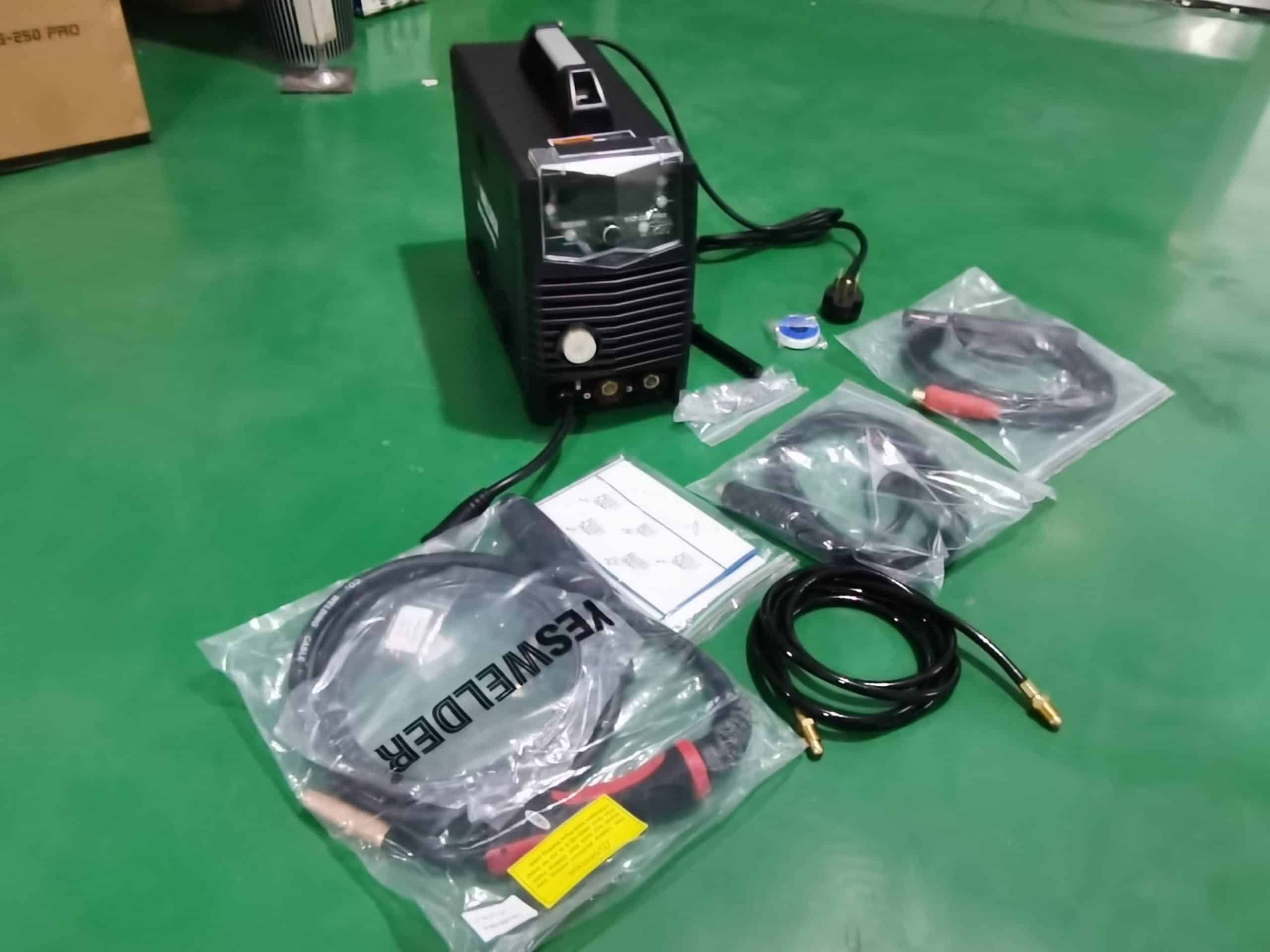
Its duty cycle is rated at 60% at 225A. While this is the highest-rated duty cycle of good quality cheap welders, keep in mind that you shouldn’t abuse it. It’s a sub $550 machine. It’s not meant to be pushed day in and day out.
Overall, this is a good beginner welder if you are looking for something powerful with a good warranty. What you lose on the arc quality, you’ll gain on the affordability, aluminum welding abilities, portability, and advanced features like 2T/4T, synergic settings, and multi-process capabilities. That’s why it sits among the top MIG welders on our list.
The full article about this machine is here.
Pros
- Lightweight
- Welding is smooth
- Very Affordable
- Quality build
- A lot of power and high-duty cycle
- Beginner-friendly
- Spool gun not needed to join aluminum
- It provides many nice features like 2T/4T
Cons
- TIG torch not included
2. Hobart Handler 210MVP 500553 MIG Welder
The Best 220v Time Tested MIG Welder
![Best MIG Welders [110V & 220V] Reviews & Buyer's Guide 2024 20 Hobart 500553 Handler 210 MVP MIG Welder](https://weldingpros.net/wp-content/uploads/2021/08/Hobart-500553-Handler-210-MVP-MIG-Welder.webp)
Hobart Handler 210MVP
Hobart Handler 210 is one of the best-selling mid-range MIG welders in the market. Thanks to Hobart’s flawless weld quality, 5/3/1 famous warranty, and in this case, better amperage output and duty cycle compared to its smaller brother Handler 140.
| Processes: | Flux Core (FCAW)/MIG (GMAW) | Weld Thickness Range: | Low-carbon steel – 1/4 in. to 3/8 in |
| Weldable Materials: | Steel, Aluminum, Stainless Steel | Input Voltage: | 110/115/120 V, 220/230/240 V. 60 Hz 60 Hz |
| Input Phase: | 1-Phase | Current Type: | DC |
| Rated Output: | 115 V, 90A @ 20%, 230V, 150A @ 30% | Amperage Range: | Not specified |
| Wire Feed Speed: | 40 IPM – 770 IPM | Weight: | 79 lbs |
I like Hobart’s play on words here. The MVP is an acronym for “multi-voltage plug,” but considering their sales of this welding machine, it could very well be the “most valuable player.” This is a transformer MIG welder, which means more durability, but also more weight. Hobart Handler 210 is a heavy machine with its 79lbs. It’s almost twice the weight of the Lincoln Power MIG 210 reviewed below. So it’s not a good choice if you have to move it around a lot.
The front panel is straightforward. It has infinite wire speed control but only seven preset values for voltage control. I hope that Hobart will update this welder in the future and give us infinite voltage control too. Almost every quality welder on the market has ditched the preset values in favor of fine-tuning the settings.
The Hobart Handler 210 is built to last. With its industrial-grade cast aluminum wire drive, sturdy metal housing, high-quality plastics on the front panel, excellent gas valve quality, big fan blades for high air-flow rate, and a transformer base, you are paying a premium price for a reason.
This Hobart is lower on our list only because many people want affordable beginner welders. It’s a great MIG welder often used for light professional work, not just DIY welding projects. Unlike YesWelder, Eastwood, and Forney, I wouldn’t be afraid to push this welder daily. Plus, it has reliable thermal overload protection.
If you can afford it and don’t mind limited features and significantly higher weight, the Hobart Handler 210 will give you excellent arc performance, outstanding durability, and an overall welding experience.
Read here the full review of the Hobart Handler 210 MVP.
Pros
- Produces smooth welding beats
- Cost-effective
- The internal fan cooling system
- Supports optional spool gun
- Thermal overload protection
- Comes with quality dual-gauge regulator
Cons
- A bit short ground clamp and MIG gun leads for the price
- Not a lightweight welder
3. Lincoln Electric PowerMIG 210Mp K3964-1 MIG Welder
The Best 220v MIG Welder For Beginers
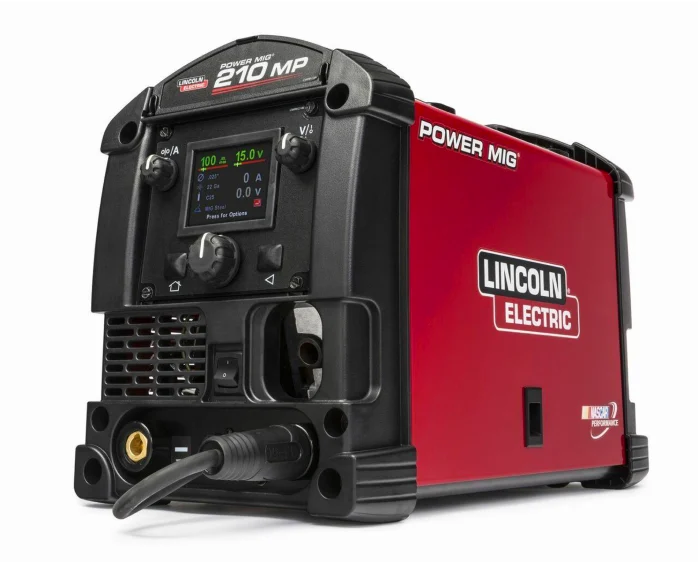
Lincoln PowerMIG 210Mp
The Power MIG 210 MP is one of the best MIG welders you can get in terms of arc quality, just like the Hobart above. It’s a professional welder offering many useful features. But unlike Hobart Handler 210, it’s an inverter making it 50% lighter, and it allows infinite adjustability of voltage, wire speed, and amperage.
| Processes: | Flux Core (FCAW)/MIG (GMAW). | Weld Thickness MIG: | Weld up to 5/16 in. mild, aluminum* up to 3/16 in. |
| Input Voltage: | 115/230/1/60Hz | Weld Thickness Flux Core: | (Self- and Gas-shielded): Tackle the biggest jobs. |
| Current Type: | DC | Weld Thickness DC Stick: | Handles up to 5/32 in. stick welder electrodes. |
| Weldable Materials: | Steel, Stainless Steel, Aluminum | Weld Thickness DC TIG: | Enabled by Touch Start TIG® technology. |
| Rated Output 120V: | 100A/19.0/40%duty cycle | Amperage Range 120V: | 20-140 Amps DC, Max. OCV: 56 |
| Rated Output 230V: | 200A/24V/25% duty cycle | Amperage Range 230V: | 20-220 Amps DC, Max. OCV: 56 |
| Wire Feed Speed: | 50-500 ipm (1.3-12.7 m/min). | Weight: | 40 lbs. |
This machine enables maximum adjustability and provides a fantastic arc. It’s a dual voltage multi-functional welder supporting MIG, Flux-core, TIG, and stick welding processes, while Hobart Handler 210 is 220V-only and doesn’t stick or TIG weld. However, Power MIG 210 costs twice as much compared to Hobart, which is why it sits low on our list of best MIG welding machines.
Housing a big digital display on the front, it’s only second to YesWelder Firstess in color and menu quality. The front panel also has three infinite adjustability knobs and two buttons arranged for intuitive use. It’s difficult to point out many negatives about this MIG welder, other than the price, compared to other welders in our comparison. However, since it’s so expensive, I have to take a more scrutinizing approach.
First off, the spool gun for aluminum is sold separately. Part no. K3269-1, Magnum PRO 100SG spool gun adds about $300 of extra cost. Plus, if you plan on TIG welding with it, the TIG torch and pedal are not included. Getting the whole setup will significantly pump the price of this Lincoln welder.
The included MIG gun and ground clamp are 10ft. long, which is fine for hobbyists, but I’d want at least 12ft for this price. The MIG gun is slightly better than Hobart’s, but I like the additional protection of the lead near the connector on Lincoln.
While portable at 40lbs, it’s still nearly double the weight of YesWelder Firstess MP200. Both offer pretty much the same level of multi-process abilities and adjustability. However, Lincoln’s superior arc and build quality come at a price of increased weight. This is not a criticism but something you should consider as you weigh your options. It has a maximum output of 210A, but the minimum output is interesting to mention. With its 20A on the low side, you can confidently weld thinner metal without burn-through.
However, its duty cycle is not the best at 25% with 200A output. This is not that bad, considering its weld quality. You can’t find machines with high-duty cycle, and beautiful arcs, made by industry-leading brand names and costing less than 2-3000 dollars. So, you either make a compromise on one of those (in this case, duty cycle), or get something like ESAB 235ic, costing twice as this Lincoln Power MIG 210.
The build is superior to every welder in our comparison. The sheet metal body is thick and sturdy, the plastics don’t feel flimsy, the knobs offer a premium tactile experience, and the screen is only beaten by YesWelder MP200. Power MIG 210 and Ironman 240 (reviewed last) are the most professional welders of our MIG welder reviews.
The machine uses an angled cast aluminum wire feed system for better wire feeding and durability. Additionally, the unit offers two cooling fans on the back to keep it running cool. While YesWelder MP200 also offers two cooling fans, the Lincoln 210MP fans are better and in line with its price. This is a multi-purpose welder that is among the best of its kind, but if you want to check the list of other multi-process welders, you can do it here. And the full review of this welding machine is in this article.
Pros
- Plug-and-play feature
- Digital controls make setup a breeze
- A large color display guides you through the setup process
- Weighs only 40 lbs (lightweight)
- Advanced options and settings
- Can be used by SMAW and TIG welders
- Supports dual-voltage inputs
Cons
- Cannot handle mass production
- Short welding gun lead for this price
4. Lincoln Electric PowerMIG 180C K2473-2 – 220V Welder
The Best Affordable Yet Branded MIG Welder
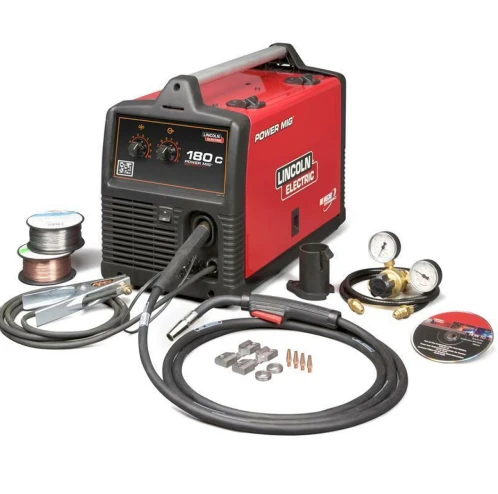
Lincoln PowerMIG 180C
Now another MIG welder from Lincoln, PowerMIG 180C, costs about 60% less than the Power MIG 210MP. However, the quality drop follows the price, and this model is much more modest in terms of features and welding power.
| Processes: | Flux Core (FCAW)/MIG (GMAW). | Weld Thickness Range: | Plain-carbon steel – 24 ga. – 1/4 in. |
| Weldable Materials: | Steel, Aluminum, and other non-rusting metal alloys. | Weld Thickness FCAW-S: self-shielded | up to 1/2 in. self-shielded Lincoln Innershield |
| Input Phase: | 1-Phase. | Input Voltage: | 208/230/1/60Hz |
| Rated Output 230: | 130A/20V/30% duty cycle. | Current Type: | DC |
| Rated Output 208: | 130A/17V/30% duty cycle. | Amperage Range: | 30-180A |
| Wire Feed Speed: | 50-500 ipm (1.3-12.7 m/min). | Weight: | 80 lbs. |
First off, it’s a 220V-input welder, so no ability to weld with a 110V home outlet. The voltage output has five pre-set values offering little adjustability, while the wire feed/amperage has an infinite adjustability knob. The unit’s front user interface is quite similar to the Hobart Handler 210. It’s straightforward to use but also limiting if you need extra arc modification.
It’s a transformer MIG welder making it heavy at 64 lbs, and providing limited duty-cycle and features. On the other hand, this results in a longer life span and better weld quality. This welder has an output range of 30-180A with a duty cycle of 30% at 130A, putting it in a similar field to Eastwood 180.
The Lincoln Electric Power MIG 180C has an angled cast aluminum drive system just like the 210MP, but with a step down in quality. It’s similar to systems found in Eastwood and YesWelder. However, those welders don’t provide wire feeding at an angle which is an advantage of Power MIG 180C. The welder comes with a MIG gun of modest quality. It doesn’t fit this price bracket because it looks like something found in much cheaper machines. Eastwood 180 or even YesWelder 205DS offer a similar MIG gun while costing less than half of the Lincoln Electric Power MIG 180C.
Overall, this is a good transformer-based MIG welder, but it doesn’t provide maximum value for the money. That’s okay; not every welder will. Just make sure you get it for the right reasons. And in this case, this is a machine suitable for welders looking for high reliability and arc quality at the cost of adjustability, weight, and some parts quality. There is an older version of this Lincoln Electric welder named Lincoln Easy MIG 180 that we removed from the list but you can still read the whole review of it here.
Pros
- Industrial-grade welder
- Sturdy build
- High-quality accessories
- Can weld up to 1/2″ thick materials
- Spool gun ready
- The cast aluminum wire drive mechanism
- Stable arc and smooth wire feed
- 3-year warranty
Cons
- Not recommended for heavy-duty jobs
- High-end welder
- Heavy, can be hard to move without welding cart
5. Hobart IronMan 240 500574001 with SpoolRunner 200
The Best Professional MIG Welder (Semi-Industrial)
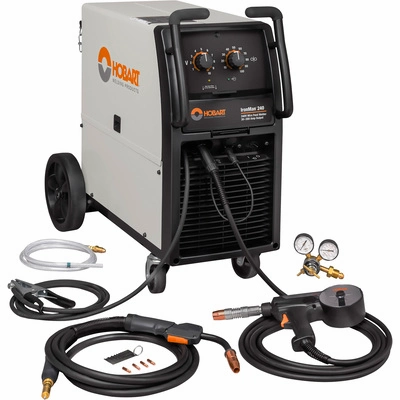
Hobart IronMan 240
Hobart IronMan 240 is a transformer welder in the full sense of the word. It’s heavy, big, and difficult to move, but it provides impeccable Hobart’s arc, lasts a lifetime, and provides massive power output. IronMan 240 is a successor to the extremely popular IronMan 230 MIG welder from Hobart
| Processes: | Flux Core (FCAW)/MIG (GMAW). | Weld Thickness Range: | Low-carbon steel 24 GA. (0.8 mm) – 1/2 in. |
| Weldable Materials: | Steel, Aluminum, inox. | Input Voltage: | 220/230/240V. |
| Input Phase: | 1-Phase. | Current Type: | DC |
| Rated Output: | 60% @ 200A duty cycle. | Amperage Range: | 30A – 280A. |
| Wire Feed Speed: | 0 IPM – 700 IPM. | Weight: | 186 lbs. |
It provides more welding power and offers infinite adjustability voltage control. Hobart finally decided to follow this market trend which is why I hope that they’ll similarly improve the Hobart Handler 210 in the future. This Hobart MIG welder has a maximum output of 280A and a maximum wire feed speed of 700 IPM, allowing you to weld thicker metal and bombard the joint if you need to fill in large openings.
The Hobart Ironman 240 also boasts a 60% duty cycle at 200A. However, unlike YesWelder and other cheaper machines offering a similar duty cycle, I feel confident in pushing IronMan to its limits daily. This unit is significantly more durable than any other welder on the list, especially inverters, making it the most reliable welder in our comparison.
Being a 240V input welder, it requires a 70A fuse. Or if you input 208V, an 80A breaker. Such breakers are not typically installed and require an additional investment.
Weighting almost 190lbs, this welder is far from portable. It does have inbuilt running gear, but it’s only helpful for small movements around the shop. It supports a spool gun for welding aluminum, and thanks to the beautiful arc, makes a great choice if you are welding aluminum daily. The 280A of output should handle most aluminum welding needs considering the heat dissipation of aluminum.
The Hobart IronMan 240 is an excellent choice if you are looking to get a great MIG welder for life and don’t mind the lack of portability. With its power, duty cycle, arc sability, and excellent build quality, it’s money well spent. While expensive, I find the high price tag wholly justified.
The 240 will be popular as 230, and the fact that it’s difficult to find stocked speaks about its demand. You can find the full review of this machine here. You can also read our review of the previous model on this page, but the Hobart Ironman 230 was discontinued so the 240 is your best bet at getting a transformer-based MIG welder that’ll last you for life.
Pros
- Smooth, easy-to-control, professional-quality arc
- Infinite wire speed and voltage dial
- Easier access to the wire drive roll system
- The internal cooling system
- High-quality build
- Transformer-based professional welder
- Built upon a proven design
- Immense power
Cons
- Short power and ground cable
- Weighs 186 lbs
- Needs a 230v or 240v outlet to run on household outlets
![Best MIG Welders [110V & 220V] Reviews & Buyer's Guide 2024 21 eastwood mig 180 welding power edited](https://weldingpros.net/wp-content/uploads/2021/09/eastwood-mig-180-welding-power-edited.webp)
MIG Welder Buyer’s Guide
As promised at the start, we have prepared a buyer’s guide with enough advice about buying a suitable MIG welder for your needs. This is our opinion and we are certain that it will help you out in your search.
Wire Feed Speed and Wire Settings
When setting up your MIG welder, you have to think about two things – the wire feed speed and the voltage. The wire feed speed is important because it controls the amperage. You will usually find the wire feed charts on the MIG machine itself. However, good advice about setting the wire feed speed is to set it at about 10% lower than the recommended settings.
But if there are no charts on the machine, just do a test run on a piece of scrap metal. You’ll know that you are where you need to be when you hear a sizzling sound similar to when frying some bacon in a pan.
Voltage Settings
Voltage settings need to coincide with the wire feed speed settings. Balancing them out will ensure efficient metal transfer. Voltage determines arc length, but it can also cause the wire to melt off.
Basically, failing to balance out the correct settings for wire feed speed and the voltage results in poor penetration.
![Best MIG Welders [110V & 220V] Reviews & Buyer's Guide 2024 22 Voltage settings on a MIG welder](https://weldingpros.net/wp-content/uploads/2020/01/Voltage-settings-on-a-mig-welder-1024x576.jpg)
If you decide to keep the voltage at the same level but lower the wire feed speed, you get more spatter and decreased penetration.
Input Power
The main focus with input power is that it has to be matched to the type of primary power available. You rarely see a DIY welder working on a piece of metal thicker than ¼ inches, which basically requires 100 amps for welding and 20 amps for plasma cutting. A 110v MIG welder to 120v can provide you with these parameters. However, for thicker pieces of metal, a machine that covers both 110v to 120v and 208v to 240v works better.
So be vary when choosing the correct input power source as your typical single-phase input (found in a home or a garage) produces 115, 200, or 230 VAC, while a three-phase (industrial work) creates 230, 460, or 575 VAC. You can find some machines that accept both single and three-phase power, with multi-voltage and no manual re-linking.
Output Power
When determining output power, welders have to have two things on their minds – the thickness of the metal and the diameter of the wire. A good piece of advice and a general rule is to use one amp of power for every .001 inch of mild steel.
Therefore, welding 1/8 in (.125 in) of low carbon steel would require around 125 amps. Stainless steel will need about 10% less while aluminum requires about 25% more power.
The diameter of wire electrodes is a bit more complicated as each one of them individually has a specific operating range. The most important thing to understand is that smaller wires carry less current while larger electrodes carry more.
| Gauge | mm | Required Amps |
| 8 | 4.2 | 165 |
| 10 | 3.4 | 135 |
| 12 | 2.7 | 105 |
| 14 | 1.9 | 75 |
| 16 | 1.5 | 60 |
| 18 | 1.2 | 48 |
| 20 | 0.9 | 36 |
| 22 | 0.8 | 30 |
| 24 | 0.6 | 24 |
Duty Cycle
A duty cycle of a welding machine is the percentage of time that it will safely be able to operate during a certain time frame at a given amperage.
So for example, if a budget MIG welder comes with a duty cycle of 40%, at 285 amps/28 volts, it means that it can properly function for 4 minutes at those parameters. After exceeding those 4 minutes, it will need to cool down before starting to weld with it once again.
![Best MIG Welders [110V & 220V] Reviews & Buyer's Guide 2024 23 Duty cycle diagram](https://weldingpros.net/wp-content/uploads/2020/01/Duty-cycle-diagram.jpg)
Welding at lower outputs will increase the duty cycle of a machine. Also, a duty cycle is evaluated at a specific ambient temperature, 104o F being the golden standard. However, with multi-process welders, that have multi-voltage welding systems, the output and duty cycle will vary depending on the input power.
Wire Feeder Mechanism Durability
The best types of wire feeders are made out of metal or aluminum. There are three basic forms of wire feeders – push, pull, and push-pull ones.
You shouldn’t skim on the wire feeder as the more quality ones are able to endure more wear and tear. Avoid the ones with a plastic mechanism as they are not going to be suitable for prolonged MIG welding.
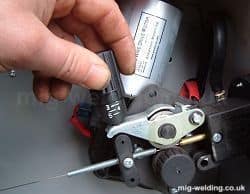
Also, it is important to replace the drive rolls from time to time. These are found in the push and push-pull feeders. Choosing and attaching the correct drive rolls that can feed the welder the correct wire dimensions will ensure fine and constant wire feeding. The most commonly used ones are:
V-knurled, V-groove, and U-groove.
Non-Industrial (110v and 220v MIG Welders)
When it comes to choosing the correct wire, there is no one-glove-fits-all solution. Both flux core and MIG welding have different characteristics that welders have to take into account first.
When picking the correct wire for the job, a welder has to consider: The thickness of the material being welded, voltage and the wire feed speed control, the correct protective gas, location, and weld appearance before making a choice. You have to understand that neither solid wire nor flux core wire is superior to the other. It basically depends on the results you are trying to achieve and the application in which you are using it.
![Best MIG Welders [110V & 220V] Reviews & Buyer's Guide 2024 25 Wire feeding apparatus for Lincoln welders](https://weldingpros.net/wp-content/uploads/2020/01/Take-up-reel-welding-wire-for-welding-semi-automatic-machine-1024x683.jpg)
Solid wire provides deeper penetration in the root and creates less spatter. Flux-core wire produces less spatter but has a larger ball-type transfer. Both self-shielded flux-cored wire and gas-shielded flux-cored wire work equally well. The main thing to focus on is how you apply it and for which type of work.
Portability and Weight
Performance is most important when choosing a metal inert gas welder, but you want to consider the size if you have limited space and if you want to avoid carrying around a giant machine.
Welders can range in size from 40 lbs. to several hundred pounds. It depends on the features and power.
The portability needs depend greatly on the kind of welding you will need to accomplish. If you have to move the welder around a great deal, there are carts available that make things a little easier.
In the case where the machine will be used for auto bodywork, the welding cart is ideal for moving around the car smoothly.
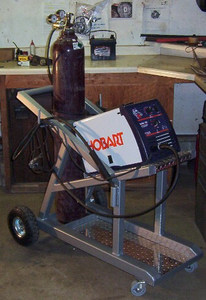
On the other side, you can weld up your own welding cart. You can find the wheels on Harbor Freight or on Amazon or in your local store. You can use ticker material and stronger metal pipes to build a cart that will never fail you.
Note: if you plan on this don’t forget to build in a gas cylinder rack on it with room for removing the gas valve (box for welding tools would be nice too).
Branding role in choosing the MIG Welders
Best brands in the welding world and is there an “iPhone” among MIG welders? When it comes to brands, there are a few staples commonly recognized in the welding industry.
Miller Electric is one of the most popular welding brands in the US. Lincoln Electric is your go-to product for TIG welders and shielded arc welding and has the most durable industrial welders.
![Best MIG Welders [110V & 220V] Reviews & Buyer's Guide 2024 27 Hobart's logo (Welding machines)](https://weldingpros.net/wp-content/uploads/2020/01/Hobart-logo.png)
Hobart is renowned for creating numerous reliable non-industrial GMAW welders and is a parent company of Miller Electric. And from Sweden, Europe If you want a piece of machinery that is meant to last, then ESAB is your choice.
However, branding is not crucial when it comes to machines built for home use.
Home hobbyists that are searching for welders for smaller projects and home repairs can find equal value in a machine of lesser quality.
![Best MIG Welders [110V & 220V] Reviews & Buyer's Guide 2024 28 Lincoln Electric's Logo](https://weldingpros.net/wp-content/uploads/2020/01/Lincoln-Electric-Logo-e1616942092485.jpg)
Bigger brands make a difference when it comes to industrial machines, while lesser-known brands work equally well for smaller types of jobs and allow you to save money.
So by buying a GMAW welder from known brands like Hobart or Miller you will not make a mistake. But if you spent some time researching you can find great machines from laser-known manufacturers that will have your money.
And did you know that there are people that make pretty good DIY welders at home also?
Gas Cylinder and Gas Selections
MIG welders with solid welding wire can’t work without shielding gas. And if you want everything to work seamlessly, you want to use the correct gas shielding combination.
A 75% argon and 25% carbon dioxide mix (75/25 or C25) is the most commonly used combination. It is known for being the best shielding gas type for welding carbon steel. It creates the best-looking beads, doesn’t cause so much spatter, and won’t burn through thinner materials.
A 100% CO2 gas offers better MIG gun cooling and slightly deeper penetration.
![Best MIG Welders [110V & 220V] Reviews & Buyer's Guide 2024 29 Close-up of a metal gas cylinder (Argon and CO2 mix) with a reducer and a pressure sensor in the background industrial workshop, side view](https://weldingpros.net/wp-content/uploads/2020/01/Close-up-of-a-metal-gas-cylinder-argon-CO2-mix-1024x682.jpg)
But the bead is not going to look as good and you will end up with more spatter. The given mixtures usually come in 40, 80, or 125 cubic feet cylinders. Choosing the one you need depends on how much welding you are planning to do. But for home use, either one is fine unless you are going to be working on a really big project.
Except for the first one the 80 and the 125 cubic feet versions of the cylinders are to heavy and are hard to move around (at least too heavy for me). You will need a cart for your welder in that case.
Spool Gun For Aluminum
Welding aluminum is not as easy as welding other materials. Aluminum is softer and a welder needs to use specific equipment for aluminum welding. This specifically goes for the aluminum wire being fed, as it is soft and can easily break if the right equipment is not in place.
This is where a MIG spool gun comes into play. If you are planning to MIG weld aluminum be sure to get a welder that has a spool gun attachment, or even better a machine that already comes with a MIG spool gun.
![Best MIG Welders [110V & 220V] Reviews & Buyer's Guide 2024 30 Spool gun for aluminum wleding on a MIG welder](https://weldingpros.net/wp-content/uploads/2020/01/Spool-gun-for-aluminum-wleding-on-a-MIG-welder.jpg)
Spool guns make things a lot easier and convenient especially if you are using softer or small diameter wire. It is also recommended for use for people who often switch from welding steel to aluminum.
Safety and Mantnense
Two integral parts of the skill set of every welder and metal worker are proper equipment maintenance and looking out for the safety of his colleagues and himself. The importance of keeping you and your welder at pick performance can not be overstated, especially in today’s turbulent times.
Both of these subjects require a few more words put into them, so we have written separate articles on both safety measures and maintenance of your new (or used) welding machine.
More on how to maintain your welding machine you can read here.
A full article on basic safety measures and the hazards that potentially await you at the workplace can be read here.
![Best MIG Welders [110V & 220V] Reviews & Buyer's Guide 2024 31 Passive welding helmets with fixed shade e1631108577351](https://weldingpros.net/wp-content/uploads/2021/08/Passive-welding-helmets-with-fixed-shade-e1631108577351.webp)
Basics of MIG Welding
We have also decided to add a part about the basics of MIG welding as it will be useful to the newer welders as they get started.
Welding Equipment Preparation
Before you start doing any kind of work, it is best to check everything and make sure your equipment is properly set. This means:
- Checking the cables – Check if they are tightly fitted and free of fraying;
- Select electrode polarity – DC electrode or reverse polarity for MIG welders;
- Set gas flow – Turn on the gas cylinder valve at a gas flow of 20 to 25 cubic feet per hour;
- Check tension – too loose or too tight can lead to poor wire feeding performance, and;
- Inspect consumables – remove excess spatter on the contact tubes and replace worn-out contact tips.
Metal Preparation
To perform quality welds first use a wire brush and/or grinding stone to remove dirt, filth, and metal corrosion from the weld groove and around 0.7 inches from it. Clean the metal to reach a metal shine on both sides of the metal plate. A good practice is also to preheat the spot that is about to be welded, preheating will remove moisture and allow for a better metal joining and more stable arc.
These practices are also good considering these welders that work on 120v and 220v household current are not industrial grade MIG Welders and have lower power and ability to remove dirt from the weld pool.
Wire selection
The use of thin wire .023 or .030 in. will prevent burning through on light materials. The use of thick MIG wire, such as .045 in., will allow for superior fusion when using more abundant metals. The two most common wire types are ER70S-3 and ER70S-6. The ER70S-3 is perfect for welding purposes of all kinds.
On the other hand, the ER70S-6 wire is typically for use on dirty and rusty surfaces when more deoxidizers are necessary.
The wire size that will be utilized for gas welding will not determine the type of machine you would want to purchase, but the device will play a part in determining the size and type of wire you will use for gas welding.
Push or Pull?
One of the greatest questions when it comes to welding is whether to use the push or pull technique. The push technique, or forehand, means moving the gun away from the weld puddle. A welder creates a flatter and a wider bead but with less penetration. The pull technique, drag or backhand, means pointing the welding gun back at the weld puddle and dragging away. The bead is narrower with more buildup while the penetration is deeper.
There is no definitive answer on which technique to use. The best approach does not exist and the best answer is that you will decide which ones to use based on the material, the equipment, and the process you are using.
Travel Angle and Work Angle
The travel angle is the angle that is relative to the gun placed in a perpendicular position. In normal welding conditions, it should be at 5 to 15 degrees, because positioning it at 20 to 25 degrees will create more spatter and cause less penetration.
The work angle is the angle where the gun position is relative to the angle of the welding joint. The angle varies based on the position and joint configuration. Therefore, the butt weld should be held at a 90-degree angle to the workpiece, the T-joint should be kept at a 45-degree angle, and the lap joint at 60 and 70 degrees.
Voltage and Amperage
Deciding on the voltage and amperage settings depends on a lot of factors. You have to take into account the thickness of the metal, welding position, joint configuration, wire diameter speed, and welding gas.
Frequently Asked Questions (F.A.Q)
What is the best 110v/220v MIG welder for a beginner?
Probably the best model of MIG welder for beginners is the Hobart 500559 Handler. This is a type of welder that has a high gas yield and a lot of power. The welder is compact and portable, perfect for inexperienced welders to move around.
Is Arc Welding stronger than MIG?
If we only consider the filler material strength, Arc Welding is not stronger than MIG welding. Electrodes for the stick and the wire used in MIG welding can utilize the same tensile strength materials. So for example, the 70 in E70s6 bare wire and the 70 in 7018 stick rods basically have the same strength. Additionally, 70,000 psi tensile strength is as strong or even stronger than the majority of steel types a person will weld.
How thick can a MIG welder weld?
Most MIG welders(that operate on 110v or on 220v) can weld up to the 3/8” (that is considered sheet metal) in a single pass. However, this will be different from welder to welder. Best that you check the chart on the MIG welder before using it. More on welding sheet metal.
What is the correct amperage for MIG welding?
There are several factors to consider when determining the correct amp welder. First of all, you need to choose a MIG welder with enough amp for the type of job you are doing. This will probably depend on the thickness of the materials you are welding. Secondly, the limitations of your electrical outlets also need to be considered.
Conclusion
The bottom line when you go to purchase your welder, you want to know your requirements well. Knowing what to look for will ensure you are making a wise investment for years to come. Remember to think about what you will regularly be welding. You want to buy the MIG welder that definitely has enough power for the jobs you need.
Higher voltage MIG machines for 220v household outlets are the way to go if you have the power outlet installed in your home. If not you can start with a 110 voltage MIG but as soon as you can install a 220v power outlet, you should go for it. Alternatively, you can buy these dual voltage machines but be warned that the price tag is quite higher.




